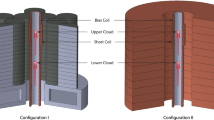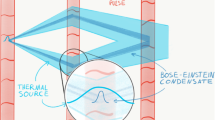Abstract
Laser-cooling of atoms and atom-trapping are finding increasing application in many areas of science1. One important use of laser-cooled atoms is in atom interferometers2. In these devices, an atom is placed into a superposition of two or more spatially separated atomic states; these states are each described by a quantum-mechanical phase term, which will interfere with one another if they are brought back together at a later time. Atom interferometers have been shown to be very precise inertial sensors for acceleration3,4, rotation5 and for the measurement of the fine structure constant6. Here we use an atom interferometer based on a fountain of laser-cooled atoms to measure g, the acceleration of gravity. Through detailed investigation and elimination of systematic effects that may affect the accuracy ofthe measurement, we achieve an absolute uncertainty of Δg/g ≈ 3 × 10−9, representing a million-fold increase in absoluteaccuracy compared with previous atom-interferometer experiments7. We also compare our measurement with the value of g obtained at the same laboratory site using a Michelson interferometer gravimeter (a modern equivalent of Galileo's ‘leaning tower’ experiment in Pisa). We show that the macroscopic glass object used in this instrument falls with the same acceleration, to within 7 parts in 109, as a quantum-mechanical caesium atom.



Similar content being viewed by others
References
Chu, S., Cohen-Tannoudji, C. & Phillips, W. D. Nobel lectures in physics 1997. Rev. Mod. Phys. 70, 685–741 (1998).
Berman, P. R. (ed.) Atom Interferometry (Academic, Chestnut Hill, 1997).
Kasevich, M. & Chu, S. Measurement of the gravitational acceleration of an atom with a light pulse atom interferometer. Appl. Phys. B 54, 321–332 (1992).
Peters, A., Chung, K. Y., Young, B., Hensley, J. & Chu, S. Precision atom interferometry. Phil. Trans. R. Soc. Lond. A 355, 2223–2234 (1997).
Gustavson, T. L., Bouyer, P. & Kasevich, M. Precision rotation measurements with an atom interferometer gyroscope. Phys. Rev. Lett. 78, 2046–2049 (1997).
Young, B. A measurement of fine-structure constant using atom interferometry. Thesis, Stanford Univ. (1997).
Ekstrom, C. R., Schmiedmayer, J., Chapman, M. S., Hammond, TD. & Pritchard, D. E. Measurement of electric polarizability of sodium with an atom interferometer. Phys. Rev. A 51, 3883–3888 (1995).
Werner, S. A. Quantum phase shifts induced by gravity and rotation. J. Phys. Soc. Jpn A 65, 51–59 (1997).
Percival, I. & Strunz, W. Detection of space-time fluctuations by a model matter interferometer. Proc. R. Soc. Lond. A 453, 431–446 (1997).
Peters, A. High precision gravity measurements using atom interferometry. Thesis, Stanford Univ. (1998).
Weiss, D. S., Riis, E., Kasevich, M., Moler, K. A. & Chu, S. in Light Induced Kinetic Effects on Atoms, Ions and Molecules (eds Moi, I., Gozzini, S., Gabbanini, C., Arimondo, E. & Strumia, F.) 35–44 (ETS Editrice, Pisa, 1991).
Kastberg, A., Phillips, W. D., Rolston, S. L., Spreeuw, R. J. C. & Jessen, P. Adiabatic cooling of cesium to 700 nK in an optical lattice. Phys. Rev. Lett. 74, 1542–1545 (1995).
Hensley, J. M., Peters, A. & Chu, S. Active low frequency vertical vibration isolation. Rev. Sci. Instrum. 70, 2735–2741 (1999).
Melchior, P. J. The Tides of Planet Earth (Pergamon, Oxford, 1983).
Scherneck, H. G. Aparameterized solid Earth tide model and ocean tide loading effects for global geodetic baseline measurements. Geophys. J. Int. 106, 677–694 (1991).
Niebauer, T. N., Sasagawa, G., Faller, J. & Hilt, R. Anew generation of absolute gravimeters. Metrologia 32, 159–180 (1995).
Borde, C. J. in Atom Interferometry (ed. Berman, P. R.) 257–292 (Academic, Chestnut Hill, 1997).
Acknowledgements
We thank G. Sasagawa, H. G. Scherneck, J. Goodkind, M. McWilliams and R.Jachens for helping in the geophysical aspects of this work. K.Y.C. was supported by the National University of Singapore. This work is supported in part by the NSF and the AFOSR.
Author information
Authors and Affiliations
Corresponding author
Rights and permissions
About this article
Cite this article
Peters, A., Chung, K. & Chu, S. Measurement of gravitational acceleration by dropping atoms. Nature 400, 849–852 (1999). https://doi.org/10.1038/23655
Received:
Accepted:
Issue Date:
DOI: https://doi.org/10.1038/23655
- Springer Nature Limited
This article is cited by
-
Cavity-enhanced metrology in an atomic spin-1 Bose–Einstein condensate
Frontiers of Physics (2024)
-
Rotation related systematic effects in a cold atom interferometer onboard a Nadir pointing satellite
npj Microgravity (2023)
-
A Decade of Advancement of Quantum Sensing and Metrology in India Using Cold Atoms and Ions
Journal of the Indian Institute of Science (2023)
-
Perspective: nanoscale electric sensing and imaging based on quantum sensors
Quantum Frontiers (2023)
-
Quantum sensing for gravity cartography
Nature (2022)





